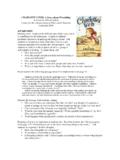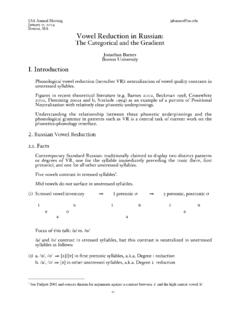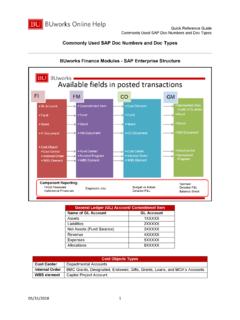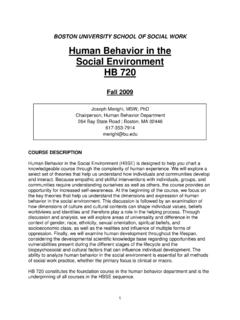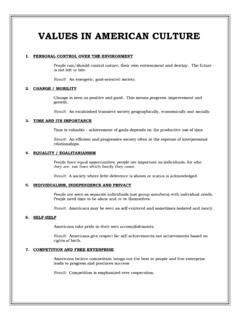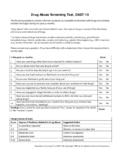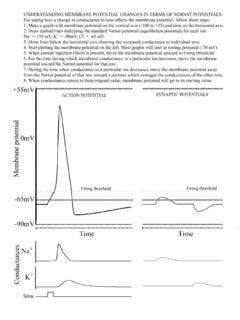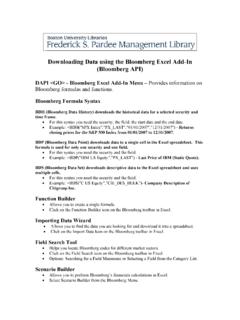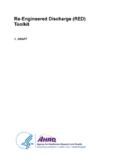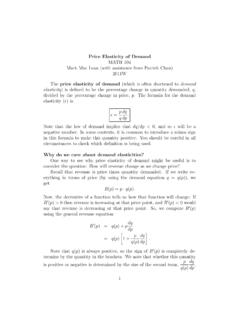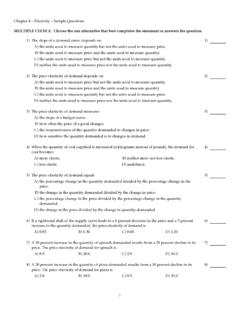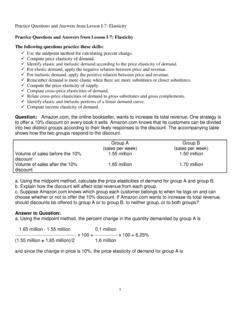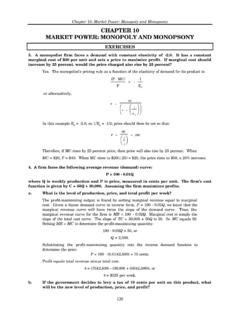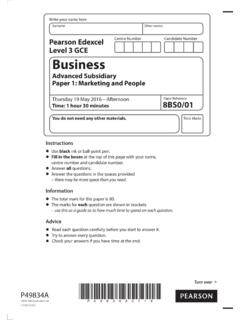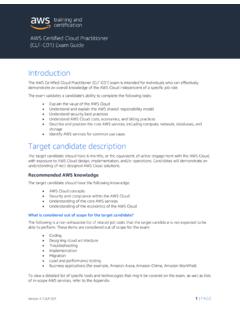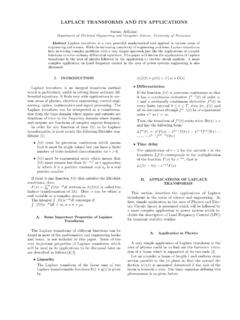Transcription of ELASTICITY - BU
1 Chapter 4 ELASTICITY 1 Chapter 4 ELASTICITY Microeconomics in Context (Goodwin, et al.), 3rd Edition Chapter Overview This chapter continues dealing with the demand and supply curves we learned about in Chapter 3. You will learn about the notion of ELASTICITY of demand and supply, the way in which demand is affected by income, and how a price change has both income and substitution effects on the quantity demanded. Objectives After reading and reviewing this chapter, you should be able to: 1. Define ELASTICITY of demand and differentiate between elastic and inelastic demand . 2. Calculate the ELASTICITY of demand . 3. Understand how to apply an ELASTICITY of demand to a business seeking to maximize revenues as well as to a policy situation. 4. Define ELASTICITY of supply and differentiate between elastic and inelastic supply. 5. Understand the income and substitution effects of a price change. 6. Discuss the differences between short-run and long-run elasticities.
2 Key Terms ELASTICITY price ELASTICITY of demand price-inelastic demand price-elastic demand price-inelastic demand (technical definition) price-elastic demand (technical definition) perfectly inelastic demand perfectly elastic demand unit-elastic demand price ELASTICITY of supply income ELASTICITY of demand normal goods inferior goods substitution effect of a price change income effect of a price change short-run ELASTICITY long-run ELASTICITY Chapter 4 ELASTICITY 2 Active Review Questions Fill in the blank 1. When you drop by the only coffee shop in your neighborhood, you notice that the price of a cup of coffee has increased considerably since last week. You decide it s not a big deal, since coffee isn t a big part of your overall budget, and you buy a cup of coffee anyway. Most of the other coffee drinkers who frequent the coffee shop make a similar calculation. Thus, the demand for coffee in your neighborhood is relatively _____.
3 2. You sell muffins for one dollar each. If you raise your price by even one penny, you will lose all your customers. The demand curve for your muffins is thus _____. 3. The responsiveness of demand to income is known as the _____ of demand . 4. The income ELASTICITY of demand is _____ for inferior goods and _____ for normal goods. 5. When demand is _____, revenue to the seller is unaffected by a price change. For Question #6, refer to the following graph: 6. For a given price range, which of the supply curves in the graph shown above is characterized by a relatively greater ELASTICITY of supply? 7. The ELASTICITY of demand is calculated as the percent change in _____ divided by the percent change in _____. 8. When quantity demanded does not respond at all to price, demand is perfectly _____. PriceQuantitySASBC hapter 4 ELASTICITY 3 9. If the price ELASTICITY of demand is greater than one, then demand is _____.
4 10. Suppose tangerines are an inferior good. This means that if your income decreases, you will buy (more/fewer) _____ tangerines. True or False 11. Perfectly elastic demand refers to a situation in which any price change for the good in question, no matter how small, will produce an "infinite" change in quantity demanded. 12. When the seller increases the price charged for a good with an elastic demand , the seller s revenues will go up. 13. ELASTICITY is the same as the slope of the demand curve. 14. Income ELASTICITY of demand is always expressed as a positive number (absolute value). 15. When the income ELASTICITY of demand is positive but less than 1, demand is called income elastic. 16. If a good is inferior and its price rises, the income effect will encourage greater expenditures, at the same time as the substitution effect pushes toward lower expenditures. Short Answer 17. Name the three main reasons why demand for a good or service might be inelastic.
5 18. You run the only lemonade stand in Central Park. If people don't buy lemonade from you, their only other option is to buy orange juice from a nearby vendor. One day, you decide to raise the price of your lemonade from $1 per glass to $ per glass. As a result, half of your usual customers decide to get orange juice instead of lemonade that day. What does this experience tell you about the demand for lemonade in Central Park? Chapter 4 ELASTICITY 4 19. A 20% increase in the price of milk leads to a 10% reduction in the quantity of milk demand . What is the price ELASTICITY of demand for milk? For Question #20, refer to the graph below. 20. The graph shown above illustrates the demand curves for two goods: Sun hats and beach balls. Which demand curve is relatively more elastic? Problems 1.
6 Draw a diagram of a perfectly inelastic demand curve. Suggest an example of a good for which demand might be perfectly elastic. 2. A limited number of Civil War uniforms have been preserved. No matter how much buyers are willing to pay for these uniforms as collectors items, there's no way to increase the quantity of uniforms in existence. Show the supply curve for authentic Civil War uniforms. PriceQuantitySun hatsBeach ballsDemand (beach balls) demand (sun hats)Chapter 4 ELASTICITY 5 For Problems #3 and #4, refer to the following graph: 3. The graph above shows the demand curve for pineapples. a. Calculate the amount of revenue the seller would receive if the price is set at $3. b. Calculate the amount of revenue the seller would receive if the price is set at $5. c. Reasoning from the results you just calculated, is the demand for bananas elastic or inelastic, in this range of prices? How do you know?
7 0123456012345 Quantity of PineapplesBADemandChapter 4 ELASTICITY 6 4. Continuing with the above example of pineapples, a. Calculate the percent change in price that occurs in moving from point A (the base case) to point B, using the midpoint formula. b. Calculate the percent change in quantity that occurs in moving from point A to point B, using the midpoint formula. c. Calculate the price ELASTICITY of demand for pineapples. 5. Suppose the demand for oranges is more price elastic in the demand for chocolate. On the graph below, indicate which line represents the demand for oranges, and which represents the demand for chocolate. PriceQuantityChapter 4 ELASTICITY 7 6. Which of the following demand curves is more elastic? Self Test 1. The price of milk doubles, but the quantity demanded changes very little. Which of the following would not be a likely explanation for this phenomenon?
8 A. There isn't a good substitute for milk. b. People feel they need milk, rather than just wanting it. c. demand for milk is highly price elastic. d. Milk is not a very big part of most people's budget. e. All of the above are likely explanations for this phenomenon. Questions 2 and 3 refer to the following scenario and graph. Bob s Bakery has two locations. The bakery decides to experiment with charging different prices at the two bakeries, to find out which price will bring in higher total revenues. The results of the experiment are shown in the graph below. PriceQuantityDemandPriceQuantityDemandPr ice of CakesQuantity of CakesDowntown BakeryUptown BakeryDemandAACBC hapter 4 ELASTICITY 8 2. The revenue earned at Downtown Bakery is equal to a. area A b. area B c. area C d. area A + B e. area B + C 3. Area A is bigger than area C. This means that a. demand for chocolate cake is highly price elastic. b. demand for chocolate cake is price inelastic.
9 C. The quantity demanded of chocolate cake exceeds the quantity supplied. d. The quantity supplied of chocolate cake exceeds the quantity demanded. e. None of the above. 4. Suppose a study finds that as people's incomes rise, they tend to buy fewer subway tokens because they are more likely to have a car. This would mean that subway tokens are a. normal goods b. inferior goods c. price elastic goods d. price taker goods e. supply elastic goods 5. The more money people make, the more pairs of shoes they buy. We can conclude that a. Shoes are a normal good. b. Shoes are an inferior good. c. demand for shoes is highly price elastic. d. demand for shoes has an ELASTICITY between 0 and 1. e. All of the above. Questions #6 and #7 refer to the following scenario: A 4% increase in the price of tomatoes leads to a 1% reduction in the quantity of tomatoes demanded. 6. The price ELASTICITY of demand for tomatoes is: a.
10 B. c. d. e. Chapter 4 ELASTICITY 9 7. Which of the following statements about the market in tomatoes is false? a. demand for tomatoes is price inelastic. b. A price increase will lead to a revenue increase. c. demand for tomatoes is unit elastic. d. Price ELASTICITY of demand equals percent change in quantity demanded, divided by percent change in price. e. All of the above are true. 8. Which of the following statements is true? a. ELASTICITY is identical to the slope of the demand curve. b. A single, straight-line demand curve can be elastic in one region and inelastic in another. c. Perfectly inelastic demand can be represented by a horizontal line. d. When demand is unit elastic, revenue is strongly affected by price changes. e. You can always determine the relative ELASTICITY of demand for two products by comparing the slope of their demand curves. 9. Suppose a 50% increase in the price of a drug results in no change in the quantity demanded.
